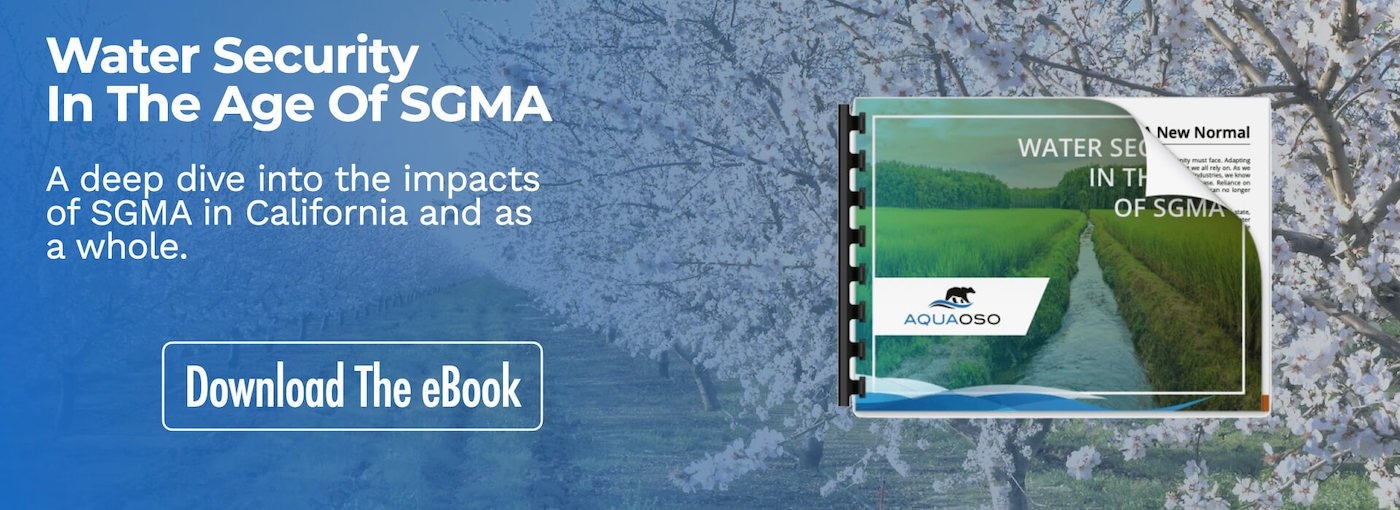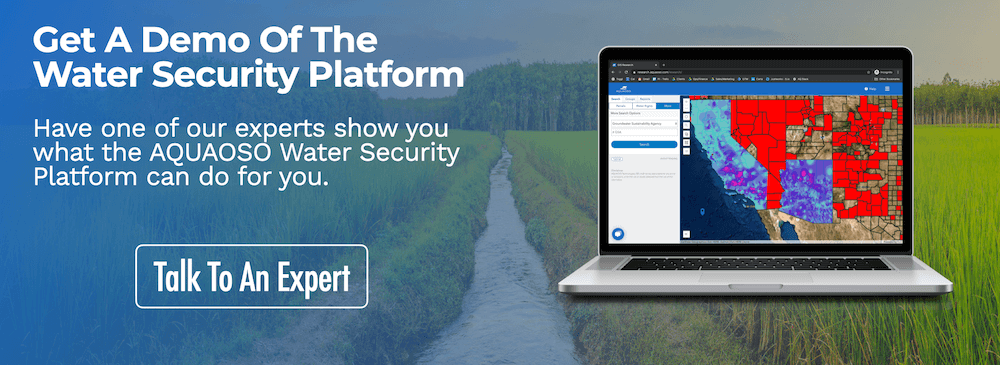Washington State Water Rights – The Evergreen State’s System
Part of our Water Rights Guide
Washington State is second only to California in terms of total agricultural exports, with over 300 different crops grown throughout the year for a total of $10 billion in value. The Washington State Department of Agriculture says this is due to its “rich volcanic soils, a diverse climate, and some of the largest irrigation systems in North America.”
But even this coastal state with a reputation for rainy weather isn’t safe from drought or abnormally dry conditions, especially east of the Cascade Mountains:
“Washington faces the third largest overall drought threat among states. By 2050, the state is projected to see a more than 300 percent increase in severity of widespread summer drought.” – States at Risk
Farmers rely on snowmelt to contribute to summer streamflow, and in 2015, the snow melted early, leaving 85% of the state in extreme drought conditions. According to the Department of Agriculture (WSDA), this resulted in economic losses as high as $633 to $773 million: “Across the Yakima Valley growers reported reductions in both yield and quality, increased fallowing, and changes in crop rotations. Some growers deferred planting permanent crops depending on access to emergency drought wells.”
While Washington is slightly less vulnerable to drought than nearby states like Oregon and Montana, water rights are going to play an incredibly important role in the years ahead.
Background on Water Rights in Washington State
Washington State water rights are based on a law passed in 1917, which determined that “those who first put water to a good use retain the right to continue using it in the future.” These rights operate on the doctrine of prior appropriation, which means that senior rights holders have priority access to water over junior rights holders.
Simply having water on your property, though, doesn’t grant you the right to use it. As the state’s Department of Ecology explains:
“Water is a resource held in common by state residents. The right to use the water is subject to regulation to ensure that water is used beneficially and to protect the environment.”
Surface water rights are governed by the 1917 Water Code, while groundwater rights are governed by the 1945 Groundwater Code. Only a few uses don’t require a permit, such as domestic and industrial use of less than 5,000 gallons per day.
Watershed Management and Irrigation Districts
In addition to a water rights permitting system, Washington state has systems in place for local municipalities to assess and manage demand for water in their basins. There are 15 Water Resource Inventory Areas (WRIAs) that can set their own policies on domestic well permit exemptions, streamflow restoration planning, and more.
There are also 101 irrigation districts that deliver water to over 1 million acres of land in the eastern part of the state. These are “funded almost entirely by the fees paid by their water-users and, as such, they are governed by elected boards of directors, much like towns and cities throughout the state.”
The Washington State Water Resources Association (WSWRA) publishes maps of the state’s irrigation districts, and you can look up the latest boundaries of WRIAs and IRs on AQUAOSO’s Water Security Platform to see them all in one place.
Other Water Resource Concerns
The Department of Ecology reports that there are over 1,100 dams in the state, some of which are primarily used for irrigation, and others for hydropower. However, recent court cases concerning dams on the Snake River have left the region in uncertainty. At issue is whether the dams will be removed to protect salmon habitats, and what impact that will have on irrigation and power generation.
Another concern is the purchase of water rights by private parties. According to a report in the Seattle Times, “the Crown Columbia Water Resources company, a private-equity backed firm [is] investing in Washington water and aiming to build a huge private water market for the Columbia River basin.”
Their argument is that the purchases will help struggling farmers and aid conservation efforts, but others worry that it will drive up the price of water. One property owner says he chose to sell his rights to Crown Columbia rather than to local farmers because “the company was willing to write big checks for the entirety of the farm’s water rights.”
How to Confirm a Water Right is Valid
These circumstances only make it more important to do due diligence when researching water rights in relation to a land deal or agricultural investment. After all, simply owning a piece of land doesn’t grant you the right to drill a well or use surface water.
A recent court case, known as the Hirst Decision, determined that “water is not legally available if a new well would impact a protected river or stream, or an existing senior water right” – which could result in the denial of building permits altogether.
Claiming or maintaining a water right associated with a property may involve:
- Processing an application with a Water Conservancy Board
- Hiring an certified water right examiner to provide a report
- Metering water use in 16 “fish-critical watersheds”
In addition, water rights can be lost if they aren’t used within a specific timeframe. The Trust Water Rights Program allows rights holders to “park,” or donate their water rights on a temporary basis, to avoid forfeiting them.
In order to research water rights in Washington State, you can use the Water Resources Explorer, which claims that 65% of water rights have been mapped as of 2018.
You can also use AQUAOSO’s Water Security Platform, which collects information from multiple sources to assess water rights and water risk on a parcel-by-parcel basis.
How to Find and Purchase Washington State Water Rights
Washington State allows for the voluntary sale or transfer of water rights, usually in the form of a water bank, a type of regional water market: “While anyone may purchase a full or partial water right directly from a willing seller, water banks can streamline the process, provide protection from relinquishment, and allow for greater flexibility.”
As water scarcity becomes a growing concern in many Western states, water trading is likely to play an even larger role in the agricultural sector. For example, a rights holder may choose to let a field go fallow in a dry year and sell their water instead. Or, they may contribute their water to aquifer recharge to withdraw in future years.
Some states have developed more technologically advanced smart water markets that can match buyers and sellers automatically. For now, the WA Department of Ecology provides an Excel spreadsheet with fee information for four water banks.
You can use these resources to research water rights, or look them up on AQUAOSO’s Water Security Platform in a more comprehensive and accessible format.
How to Present a Water Right Analysis
Water rights aren’t just an abstract asset. They determine which crops are viable on a given piece of land, and how susceptible a particular grower is to drought risk. Pricing water risk directly into your loans can help you make better land deals and more reliable investment decisions. After all, water risk is business risk.
Here’s how lenders can use water rights information to assess a loan:
- First, loan officers can determine that the water rights in question are valid and linked to a reliable water source. This reduces the overall risk of the loan application.
- A senior manager or credit officer can provide water rights data to regulators, addressing any concerns relating to water risk.
- Senior managers can provide the analysis to investors or to the board of the bank, to highlight any water security issues.
Water rights can have major effects on both the livelihood of individual growers, and on the nation’s supply chains. Remember, Washington’s 2015 drought affected dozens of crops, including “apple, cherry, hops, blueberry, wine grape,” and more.
The Department of Agriculture recommends “identifying which growers rely on surface and groundwater, which have water rights that are susceptible to curtailment in low water years, and where access to emergency drought wells exists.”
Lenders and investors can play a role in this process, by putting their influence behind drought mitigation strategies and responsible water use in agriculture.
You can read more about state-by state water rights in our Water Rights Guide.
The Bottom Line
Researching water rights in Washington can involve a lot of work, especially if it means analyzing spreadsheets and comparing datasets from several basins, water banks, or irrigation districts. AQUAOSO is committed to simplifying the process by providing the information and data needed to make the right water decisions through the Water Security Platform.
Users can look up the boundaries of Water Resource Inventory Areas, look up records of existing water rights, and view specific, granular data for a specific parcel of land.
Learn more about water security by browsing our free resource library, or contact us directly for a free demo or consultation!
Recent Posts
Sustainable Agriculture Practices That Need Financial Capital
In late 2021, world leaders gathered in Glasgow for COP26, better known as the UN’s climate change conference. With over 25,000 attendees meeting to discuss the efforts needed to address climate change, themes of sustainability, renewable energy and the reduction of...
2022 Sustainable Agriculture Trends for Ag Finance to Be Aware of
With real-world impacts like rising global temperatures, climate change is one of the biggest risk factors agriculture faces today. NOAA reported that 2020 was the second warmest year and the EPA explains a consistent increase of 0.16°F in average surface temperature...
Crucial Ways Agricultural Bank Services Can Contribute to A Sustainable Ag Economy
Ag banks and Farm Credits, enable agribusinesses to attain the financing they need in order to execute functions like harvesting and planting, as well as buying new equipment and combat overhead costs. They allow farmers to operate by engaging in a relationship with...






